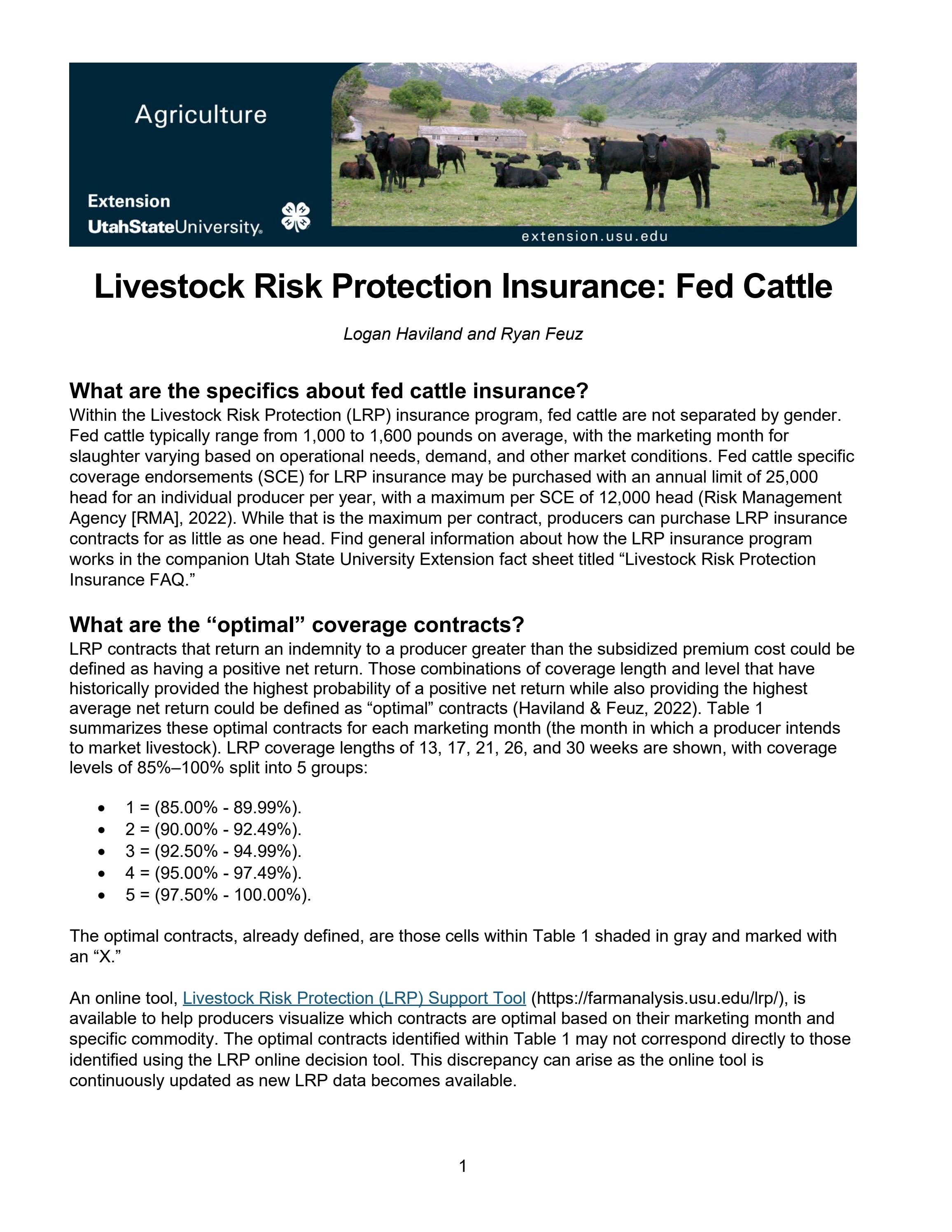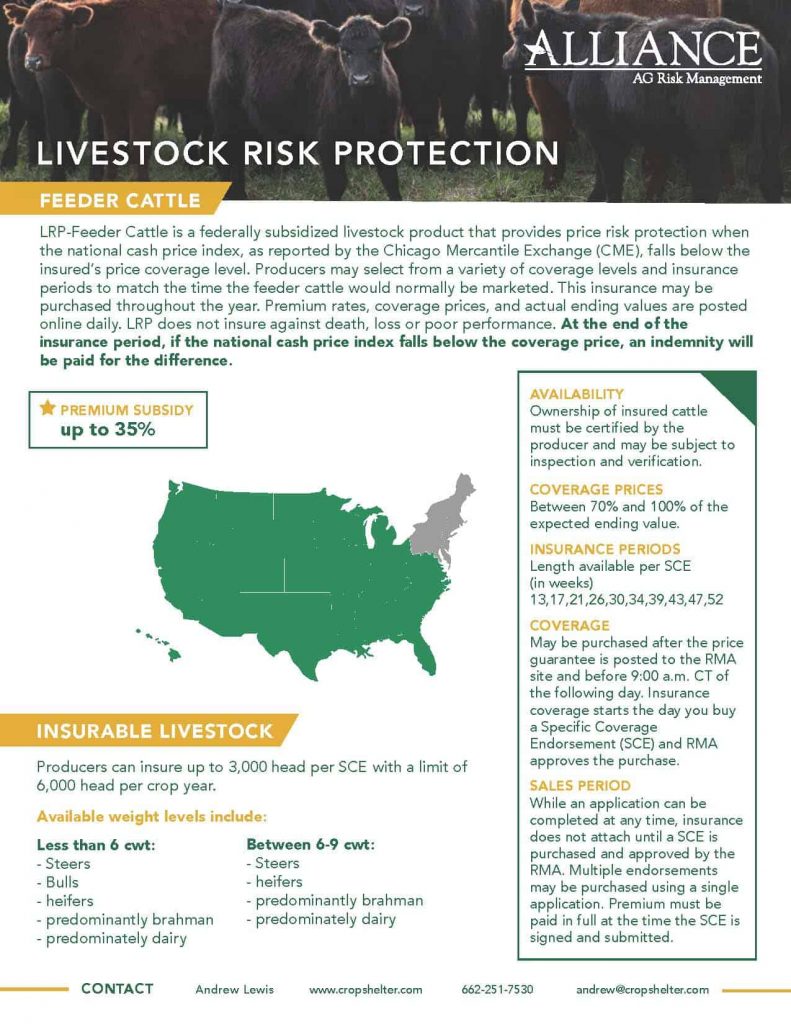Strategic Collaborations for Resilience: Bagley Risk Management
Wiki Article
Secret Aspects to Take Into Consideration When Choosing Livestock Risk Security (LRP) Insurance Coverage
When reviewing alternatives for Animals Threat Protection (LRP) insurance, several key elements require cautious consideration to make sure efficient threat management in the agricultural sector. Selecting the best protection alternatives tailored to your particular animals operation is extremely important, as is comprehending exactly how superior expenses correlate with the level of security offered. Additionally, the eligibility criteria for various kinds of livestock and the versatility of the policy to adapt to changing scenarios are crucial aspects to evaluate. The effectiveness and openness of the insurance claims process can dramatically affect the general experience and economic results for livestock producers. By tactically navigating these critical aspects, producers can protect their financial investments and alleviate potential threats efficiently.Protection Options
When taking into consideration Livestock Danger Security (LRP) insurance coverage, it is essential to comprehend the numerous coverage alternatives offered to alleviate risks in the agricultural industry. Animals Risk Security (LRP) insurance policy offers various insurance coverage options customized to fulfill the diverse requirements of animals producers. Bagley Risk Management. Among the main protection alternatives is cost insurance coverage, which secures versus a decrease in market value. Manufacturers can pick the protection level that aligns with their price risk management objectives, allowing them to secure their operations against possible monetary losses.One more essential insurance coverage option is the recommendation duration, which determines the size of time the coverage is in result. Producers can pick the recommendation duration that ideal matches their production cycle and market problems. In addition, protection levels and rates differ based upon the sort of animals being guaranteed, providing manufacturers the versatility to customize their insurance plans according to their certain needs.
Understanding the various coverage alternatives offered under Livestock Threat Defense (LRP) insurance is vital for manufacturers to make educated choices that successfully safeguard their animals procedures from market unpredictabilities.
Premium Prices

Animals Threat Protection (LRP) insurance gives necessary coverage options customized to mitigate risks in the agricultural market, with a significant facet to think about being the computation and framework of premium expenses. When figuring out premium expenses for LRP insurance policy, several factors come into play. These include the type and number of animals being guaranteed, the coverage level picked, the current market value, historical rate information, and the size of the protection duration. Insurance firms may likewise consider the place of the farm, as geographic factors can impact the overall danger profile.
Premium costs for LRP insurance are usually determined based on actuarial data and risk evaluation models. Insurance firms assess historic data on livestock costs and production expenses to establish an ideal costs that shows the degree of risk entailed. It is essential for livestock manufacturers to thoroughly review premium prices and coverage alternatives to ensure they are adequately shielded versus prospective monetary losses because of damaging market conditions or unexpected occasions. By comprehending exactly how exceptional expenses are determined and structured, manufacturers can make educated decisions when selecting the right LRP insurance plan for their operation.
Qualified Animals
The resolution of qualified animals for Livestock Danger Protection (LRP) insurance policy protection involves careful consideration of particular standards and features. Animals kinds that are normally eligible for LRP insurance policy consist of feeder livestock, fed lambs, livestock, and swine.Feeder livestock, for example, are frequently qualified for LRP protection if they fall within specified weight ranges. Lambs are recommended you read one more category of livestock that can be considered for LRP insurance coverage, with factors such as weight and age playing a critical function in establishing their qualification.
Before picking LRP insurance coverage for animals, producers must very carefully examine the qualification requirements described by the insurance coverage company to ensure their pets fulfill the essential demands for insurance coverage.
Plan Flexibility
Policy flexibility in Animals Risk Security (LRP) insurance policy allows manufacturers to tailor insurance coverage to fit their particular needs and risk monitoring strategies. This adaptability empowers animals producers to customize their insurance coverage based on aspects such as the sort of livestock they possess, market conditions, and specific threat resistance degrees. One essential facet of policy flexibility in LRP insurance is the ability to pick insurance coverage degrees that straighten with the manufacturer's monetary objectives and take the chance of direct exposure. Manufacturers can select protection degrees that shield them versus potential losses because of variations in animals rates, guaranteeing they are properly insured without paying too much for unnecessary protection. Additionally, LRP insurance policy offers versatility in policy duration, enabling producers to pick coverage periods that finest fit their production cycles and marketing timelines. By offering customizable choices, LRP insurance coverage allows producers to successfully handle their threat direct exposure while safeguarding their animals procedures versus unanticipated market volatility.Claims Process
Upon experiencing a loss or damage, producers can start the claims procedure for their Animals Threat Defense check my reference (LRP) insurance coverage by without delay calling their insurance company. It is essential for producers to report the loss asap to expedite the claims procedure. When reaching out to the insurance service provider, manufacturers will require to give comprehensive information concerning the event, including the day, nature of the loss, and any kind of pertinent paperwork such as veterinary records or market costs.
After the assessment is full, the insurance copyright will make a choice relating to the claim and interact the end result to the producer. The manufacturer will get settlement according to the terms of their Livestock Risk Protection (LRP) insurance coverage policy if the insurance claim is accepted. It is essential for producers to be acquainted with the claims process to make sure a smooth experience in case of a loss

Conclusion
To conclude, when selecting Livestock Risk Protection (LRP) insurance, it is necessary to consider coverage options, premium costs, qualified animals, plan versatility, and the insurance claims process. These essential elements will help ensure that farmers and ranchers are appropriately secured against possible dangers and losses related to their animals procedures. Making an informed choice based upon these factors to consider can eventually bring about far better monetary safety and security and peace of mind for animals producers.Livestock Risk Defense (LRP) insurance policy provides various protection choices tailored to fulfill the diverse requirements of animals manufacturers.The decision of qualified livestock for Livestock Danger Defense (LRP) insurance coverage entails mindful factor to consider of specific requirements and qualities.Policy flexibility in Livestock Threat Protection (LRP) insurance permits producers to tailor coverage to match their particular demands and run the risk of monitoring methods.Upon experiencing a loss or damages, producers can launch the claims procedure for their Animals Danger Defense (LRP) insurance by immediately calling their insurance provider.In final thought, when picking Livestock Danger Defense (LRP) insurance, it is vital to More Help take into consideration coverage choices, premium prices, eligible livestock, plan adaptability, and the claims process.
Report this wiki page